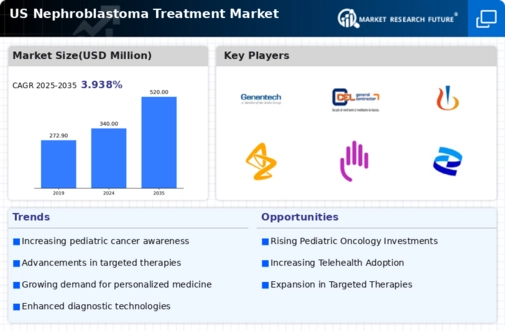Increasing Incidence Rates
The nephroblastoma treatment market is experiencing growth due to rising incidence rates of nephroblastoma, particularly among children. Recent data indicates that nephroblastoma accounts for approximately 5% of all childhood cancers in the United States. This increase in cases necessitates enhanced treatment options and drives demand for innovative therapies. As healthcare providers seek to address this growing patient population, investments in research and development are likely to rise. The market is projected to expand as new treatment modalities are introduced, aiming to improve survival rates and quality of life for affected children. Consequently, the increasing incidence rates of nephroblastoma are a significant driver for the nephroblastoma treatment market, prompting stakeholders to focus on effective treatment strategies.
Advancements in Treatment Modalities
The nephroblastoma treatment market is significantly influenced by advancements in treatment modalities. Recent innovations in chemotherapy, radiation therapy, and surgical techniques have improved patient outcomes. For instance, the introduction of targeted therapies has shown promise in enhancing the efficacy of treatment while minimizing side effects. The market is projected to grow as these advanced treatment options become more widely adopted. Furthermore, clinical trials are continuously exploring new combinations of therapies, which may lead to more effective treatment regimens. As a result, the nephroblastoma treatment market is likely to benefit from ongoing research and development efforts aimed at refining treatment approaches and improving survival rates.
Rising Awareness and Early Detection
The nephroblastoma treatment market is positively impacted by rising awareness and early detection of the disease. Educational campaigns aimed at parents and healthcare providers are enhancing knowledge about nephroblastoma symptoms and the importance of early diagnosis. This increased awareness is leading to earlier interventions, which can significantly improve treatment outcomes. In the United States, early detection initiatives have contributed to a 20% increase in diagnosed cases at earlier stages, allowing for more effective treatment strategies. As awareness continues to grow, the nephroblastoma treatment market is likely to see an uptick in demand for therapies that cater to early-stage patients, ultimately improving survival rates.
Collaboration Between Healthcare Stakeholders
The nephroblastoma treatment market is driven by collaboration between various healthcare stakeholders, including hospitals, research institutions, and pharmaceutical companies. These partnerships facilitate the sharing of knowledge and resources, leading to accelerated development of new treatment options. Collaborative efforts are particularly evident in clinical trials, where multi-institutional studies are becoming more common. This trend enhances the ability to gather comprehensive data on treatment efficacy and safety, which is crucial for regulatory approvals. As these collaborations continue to strengthen, the nephroblastoma treatment market is expected to benefit from a more robust pipeline of innovative therapies, ultimately improving patient outcomes.
Increased Funding for Pediatric Cancer Research
The nephroblastoma treatment market is bolstered by increased funding for pediatric cancer research. Government initiatives and private organizations are allocating substantial resources to advance research in childhood cancers, including nephroblastoma. In 2025, funding for pediatric cancer research in the United States is expected to exceed $500 million, reflecting a growing commitment to understanding and treating these conditions. This influx of capital supports the development of novel therapies and clinical trials, which are essential for improving treatment outcomes. As research progresses, the nephroblastoma treatment market is likely to expand, driven by the introduction of innovative treatment options that arise from this increased funding.

















Leave a Comment